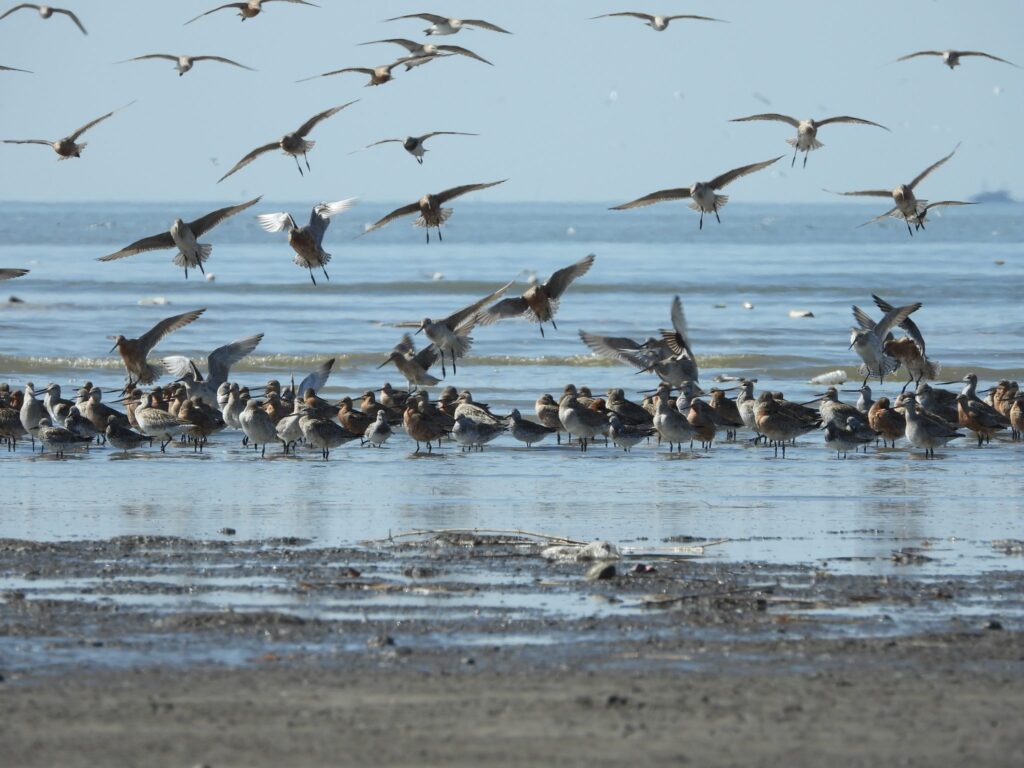Gaze out to sea and a flock of shore birds suddenly emerges from the shallow, muddy water, moving gracefully in a flock. There are few other places in East Asia where you can see so many migratory birds in one place. This is China’s Yellow Sea-Bohai Bay Migratory Bird Sanctuary, a newly designated UNESCO World Heritage Site.
Dr Ding Li Yong, Asia Regional Flyways Coordinator, spoke of a recent trip to these very places: “I visited the Yalu River estuary at Dandong a few years ago and was awed by the hordes of migratory birds circling around the mudflats. I remember seeing well over 50,000 Red Knots!”
On 26 July 2024, five of these special migratory bird sanctuaries were inscribed as UNESCO World Heritage Sites. This prestigious recognition recognises the vital importance of these wetland habitats to migratory birds along the East Asian-Australasian Flyway (EAAF).
Every spring and autumn, millions of birds migrate along the EAAF from northern Russia across continental Asia to Australia and New Zealand. Birds such as the critically endangered Spoon-billed Sandpiper, Siberian Crane and the endangered Curlew stop in the Yellow Sea wetlands to rest and refuel for the long journey.
Across the flight path, large wetlands like these tidal flats and salt marshes are rapidly disappearing. Development and rising sea levels are squeezing the wetlands on both ends. This makes it difficult for birds to find food and rest during their migration. These UNESCO-designated areas along the Yellow Sea help ensure species can reach their destinations safely.
BirdLife International wholeheartedly welcomes the inclusion of these sites as habitats for migratory waterbirds. BirdLife, in collaboration with the Asian Development Bank and the East Asia-Australia Flyway Partnership, is working to promote the importance of conservation management of these sites as key areas of the Regional Flyway Initiative (RFI), which aims to protect ecologically connected wetlands important to birds and people across the continent through innovative funding and conservation techniques.
The diverse wetlands around the Yellow Sea not only provide food for millions of migratory birds, but are also invaluable to humans. The 2023 Yellow Sea State Analysis, compiled with the support of BirdLife International, highlights this value, stating: “Yellow Sea tidal flats are of immense value to human communities, providing billions of dollars per year in ecosystem services including blue carbon sequestration, and protecting one of the world’s most densely populated coastal regions from the impacts of storms and sea-level rise.”
The five newly inscribed migratory bird sanctuaries are a second phase expansion of the existing Yellow Sea-Bohai Bay (Phase 1) World Heritage Site, which was inscribed in 2019. This continued effort demonstrates the Chinese Government’s commitment to protecting wetlands that are important for both migratory birds and the communities that live nearby.
BirdLife recognises this timely contribution to China’s long-term plans to protect its wetland ecosystems.
“The designation of five new World Heritage sites is fantastic news for migratory birds as it will increase both their visibility and conservation. But it will also help fight climate change as these sites sequester more carbon and provide essential services to people. We congratulate China and all those who worked hard to secure these designations – reinforcing the importance of the Yellow Sea to the entire East Asian-Australasian Flyway.” – Martin Harper, CEO, BirdLife International

